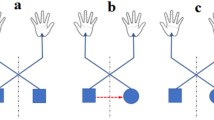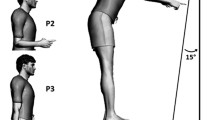Abstract
We previously demonstrated a tendency to perform arm movements by using a trailing joint control pattern during which either the shoulder or elbow is rotated actively and the other (trailing) joint is rotated predominantly passively, by interaction torque during horizontal movements and by interaction and gravitational torque during 3D arm movements. This tendency was established with a free-stroke drawing task that required production of series of strokes in randomly selected directions from the center to the perimeter of a horizontal circle. The studies demonstrated that within a planar workspace, the usage of the trailing pattern depends on movement direction and the most frequently selected directions are those providing the opportunity to use the trailing pattern. Here, we studied whether the opportunity to use the preferred trailing pattern also depends on the orientation of the planar workspace. The free-stroke drawing task was performed with unconstrained arm movements within circles of a left-diagonal (LD) and right-diagonal (RD) orientation. Two pronounced preferred directions were revealed in the LD condition, and they were the directions in which the trailing pattern was used. Directional preferences were less pronounced, and the trailing pattern was not observed in any directions in the RD condition. Also, subjects identified the RD condition as inconvenient. The results reinforce the previous finding of the propensity to use the trailing pattern during arm movements. They also suggest that orientations of the workspaces in manual activities should be designed to support the trailing pattern as a favored type of joint control.





Similar content being viewed by others
References
Alexander RM (1997) A minimum energy cost hypothesis for human arm trajectories. Biol Cybern 76:97–105
Asmussen M, Przysucha E, Dounskaia N (2014) Intersegmental dynamics shape joint coordination during catching in typically developing children but not in children with developmental coordination disorder. J Neurophysiol 111:1417–1428
Bowman AW, Azzalini A (1997) Applied smoothing techniques for data analysis: the Kernel approach with S-Plus illustrations. Clarendon, Oxford
De Leva P (1996) Adjustments to Zatsiorsky–Seluyanov’s segment inertia parameters. J Biomech 29:1223–1230
Dounskaia N, Goble J (2011) The role of vision, speed and attention in overcoming directional biases during arm movements. Exp Brain Res 209:299–309
Dounskaia N, Wang W (2014) A preferred pattern of joint coordination during arm movements with redundant degrees of freedom. J Neurophysiol 112:1040–1053
Dounskaia NV, Swinnen SP, Walter CB, Spaepen AJ, Verschueren SMP (1998) Hierarchical control of different elbow-wrist coordination patterns. Exp Brain Res 121:239–254
Dounskaia NV, Ketcham CJ, Stelmach GE (2002) Influence of biomechanical constraints on horizontal arm movements. Mot Control 6:368–389
Dounskaia N, Wisleder D, Johnson TA (2005) Influence of biomechanical factors on substructure of pointing movements. Exp Brain Res 164:505–516
Dounskaia N, Goble J, Wang W (2011) The role of intrinsic factors in control of arm movement direction: implications from directional preferences. J Neurophysiol 105:999–1010
Dounskaia N, Wang W, Sainburg RL, Przybyla A (2014) Preferred directions of arm movements are independent of visual perception of spatial directions. Exp Brain Res 232:575–586
Feltner ME, Nelson ST (1996) Three-dimensional kinematics of the throwing arm during the penalty throw in water polo. J Appl Biomech 12:359–382
Furuya S, Kinoshita H (2007) Roles of proximal-to-distal sequential organization of the upper limb segments in striking the keys by expert pianists. Neurosci Lett 421:264–269
Furuya S, Kinoshita H (2008) Expertise-dependent modulation of muscular and non-muscular torques in multi-joint arm movements during piano key stroke. Neuroscience 156:390–402
Goble J, Zhang Y, Shimansky Y, Sharma S, Dounskaia N (2007) Directional biases reveal utilization of arm’s biomechanical properties for optimization of motor behavior. J Neurophysiol 98:1240–1252
Guigon E, Baraduc P, Desmurget M (2007) Computational motor control: redundancy and invariance. J Neurophysiol 97:331–347
Harris C, Wolpert D (1998) Signal-dependent noise determines motor planning. Nature 394:780–784
Hirashima M, Ohtsuki T (2008) Exploring the mechanism of skilled overarm throwing. Exerc Sport Sci Rev 36:205–211
Hirashima M, Kudo K, Ohtsuki T (2007) A new non-orthogonal decomposition method to determine effective torques for three-dimensional joint rotation. J Biomech 40:871–882
Hogan N (1985) The mechanics of multi-joint posture and movement control. Biol Cybern 52:315–331
Hunter L, Hendrix E, Dean J (2010) The cost of walking downhill: is the preferred gait energetically optimal? J Biomech 43:1910–1915
Isableu B, Rezzoug N, Mallet G, Bernardin D, Gorce P, Pagano CC (2009) Velocity-dependent changes of rotational axes in the non-visual control of unconstrained 3D arm motion. Neuroscience 164:1632–1647
Kistemaker D, Wong J, Gribble P (2010) The central nervous system does not minimize energy cost in arm movements. J Neurophysiol 104:2985–2994
Kistemaker D, Wong J, Gribble P (2014) The cost of moving optimally: kinematic path selection. J Neurophysiol 112:1815–1824
Lee G, Fradet L, Ketcham CJ, Dounskaia N (2007) Efficient control of arm movements in advanced age. Exp Brain Res 177:78–94
Minnotte MC (1997) Nonparametric testing of the existence of modes. Ann Statist 25:1646–1660
Scheidt RA, Ghez C, Asnani S (2011) Patterns of hypermetria and terminal cocontraction during point-to-point movements demonstrate independent action of trajectory and postural controllers. J Neurophysiol 106:2368–2382
Shimansky YP, Rand MK (2013) Two-phase strategy of controlling motor coordination by task performance optimality. Biol Cybern 107:107–129
Todorov E (2004) Optimality principles in sensorimotor control. Nat Neurosci 7:907–915
Todorov E, Jordan MI (2002) Optimal feedback control as a theory of motor coordination. Nat Neurosci 5:1226–1235
Wang W, Dounskaia N (2012) Load emphasizes muscle effort minimization during selection of arm movement direction. J Neuroeng Rehabil 9:70
Wang W, Johnson T, Sainburg RL, Dounskaia N (2012) Interlimb differences of directional biases for stroke production. Exp Brain Res 216:263–274
Acknowledgments
Wanyue Wang was supported by the Kinesiology Graduate Program, ASU.
Author information
Authors and Affiliations
Corresponding author
Rights and permissions
About this article
Cite this article
Wang, W., Dounskaia, N. Influence of workspace constraints on directional preferences of 3D arm movements. Exp Brain Res 233, 2141–2153 (2015). https://doi.org/10.1007/s00221-015-4285-x
Received:
Accepted:
Published:
Issue Date:
DOI: https://doi.org/10.1007/s00221-015-4285-x




